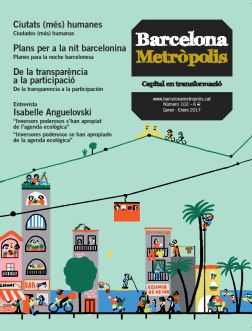Talking about humane cities or cities with dignity puts us in the territory of the basic needs that must be guaranteed to the city’s inhabitants. It’s important to put people and groups centre-stage when working to achieve this goal.

The expression “right to the city” aims to place the need for cities to ensure that their residents enjoy the right to decent housing, work and environmental conditions and access to basic services on the urban agenda over the next 20 years.
Photo: Vicente Zambrano
In the recent United Nations summit on cities, held in Quito in October, one of the new concepts that was most feted by progressive entities and organisations from all over the world was the inclusion of the so-called “right to the city”. This term seeks to include on the new urban agenda for the next twenty years the fact that cities must ensure their inhabitants have decent living conditions in terms of employment, housing, the environment and access to services considered as basic. As we might imagine, although we talk about the “right to the city”, this is more of a desire to put the demand for minimum living standards at the core of policies that countries should apply to their cities, than a true right that offers certain guarantees and that can be claimed before the courts.
So talking today about humane cities or cities with dignity puts us in the territory of the basic needs that must be guaranteed to the city’s inhabitants. The literature on the subject talks about a mix of health, conditions for personal autonomy (work, housing, education, etc.) and the ability to freely make decisions. If we bear all these elements in mind, we might say that cities should be able to guarantee healthy living conditions for their inhabitants. As we know, there are many social factors that intervene in people’s health, often linked to things like diet and lifestyle, housing conditions, the degree of exposure to pollution (especially in the air we breathe), level of education and, obviously, the disposable income that can guarantee good parameters for all of the above. So we can see that health and the conditions for personal autonomy are closely linked.
One of the indicators that is used to measure health is life expectancy. In Barcelona, for example, according to the latest reports by the city’s health agency, there is a difference of up to eleven years between the neighbourhoods with the highest life expectancy and those with the lowest. While this may look like a very big difference, it is actually not extreme, because even in other parts of Europe one can find considerably larger gaps. Nevertheless, in Barcelona and its metropolitan area we do have specific issues that mean we must remain alert and keep working to prevent these basic conditions from getting worse. It is worth remembering that L’Hospitalet, Barcelona, Santa Coloma, Badalona and Cornellà are the five most dense cities in Spain, and while this does have advantages (less land given over to low density housing, more services which are more accessible, etc.), it also creates problems when mobility is strongly focused on the use of private and public vehicles that are polluting, and when there are significant rates of inequality, because this leads to conflict and to problems when it comes to living side-by-side in the community.
I shall not spend too much time on the housing issue, as another article in this magazine covers the subject in depth, but it is obvious that housing is vital for the right to the city, and is even considered to be a pre-distributive aspect. We do not have a good starting point for guaranteeing good access to housing, because of the low ratio of council-owned housing in our cities.
Location is also important; it’s not the same living in one area of the city as in another, despite the high density we’ve already mentioned. The term “location effect” refers to the fact that the spot at which one lives in the city defines a whole spectrum of different life opportunities that have to do with the degree of diversification of access to services and products. Even the neighbourhood’s terrain influences people’s levels of autonomy and mobility, in the same way as the map of amenities that residents either want or don’t want makes big differences that some people refer to by the term “spatial justice”.
This whole set of conditions also extends to levels of disposable income, which again is unequally distributed around different parts of our cities. In the ten districts and seventy-three neighbourhoods of Barcelona, the differences have continued and in some cases increased over the last thirty years. There are notable features which have remained steady and a few small changes caused by the major urban redevelopments, such as those implemented in the run-up to the Olympic Games of 1992. But it is still true that the average income of the closest neighbourhood on the scale is seven or eight times higher than the very lowest-income neighbourhood. Public policy makers must be very aware of these differences and try to bridge the gaps with concrete actions, while avoiding the stigmatisation that often occurs. Barcelona has a more dense, compact and integrated urban fabric than other cities and this makes it difficult (but not impossible) for ghettos to appear.
In Barcelona and its metropolitan area, immigration is a phenomenon that has made itself felt very strongly since the turn of the millennium. So within the parameters that must guide our actions to create humane cities with dignity, it is important not to underestimate the value of diversity. It has been well researched that the age, gender and origin of each city dweller are all factors that can intensify their risk of exclusion. That is why public institutions or social organisations must avoid working in a homogeneous fashion, indifferent to this diversity. The opposite of equality is inequality, not diversity. This fact must be taken on board and it must be accepted that all people have the same dignity, by personalising services and actions.
At the start of this reflection we said that it is also important to put people and groups centre-stage when working to achieve more humane and dignified cities. This means avoiding hierarchical and patriarchal mindsets when thinking, designing and implementing actions to achieve these goals. It is important, then, to create processes for participation and co-production when developing urban policies, to stop the authorities and the technical experts from taking over the stage because they tend to distance the people, organisations and spaces affected from any involvement in these goals. This would allow us to get closer to this aspiration of the “right to the city”, which is a clean break with the idea that a city builds itself or is subject to the dynamics of property speculation and the interests of large corporations and investment funds.






